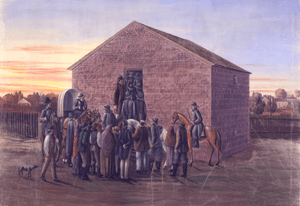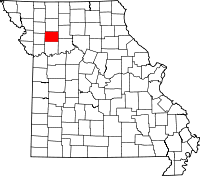Far West, Missouri
|
Far West | |
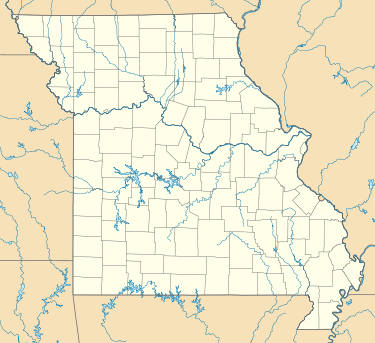  | |
| Location | 5.5 miles (8.9 km) west of Kingston via County Roads D and H, near Kingston, Missouri |
|---|---|
| Area | 640 acres (260 ha) |
| Built | 1836 |
| NRHP reference # | 70000324[1] |
| Added to NRHP | September 22, 1970 |
| Far West Missouri Temple | |||||||||||||||||
|---|---|---|---|---|---|---|---|---|---|---|---|---|---|---|---|---|---|
| Efforts halted in 1830s | |||||||||||||||||
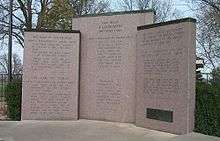 Monument at the temple site in Far West. | |||||||||||||||||
| Official website• News & images | |||||||||||||||||
| |||||||||||||||||
Far West was a settlement of The Church of Jesus Christ of Latter-day Saints in Caldwell County, Missouri, United States. It is recognized as a historic site by the U.S. National Register of Historic Places.
Foundation and early history
The town was founded by Missouri leaders of The Church of Jesus Christ of Latter-day Saints, W. W. Phelps and John Whitmer in August 1836 shortly before the county's creation. The town was platted originally as a 1-mile (1.6 km) square area, centered on a public square which was to house a temple. The design of the town resembled the plan of Joseph Smith Jr. (the first prophet of The Church of Jesus Christ of Latter-day Saints) for the City of Zion, which had been planned to be built in the town of Independence, Jackson County, Missouri. As the town of Far West grew, the plat was extended to 4 square miles (10 km2).[2]
Early Latter-day Saints began to settle in northwestern Missouri soon after the Church of Jesus Christ of Latter Day Saints was organized in 1830. According to a revelation given by Joseph Smith Jr., Independence would be the "centerplace" of the City of Zion when Jesus returned. However, disputes between early members of The Church of Jesus Christ of Latter-day Saints and Missourian settlers in Independence led to the expulsion of the early members of The Church of Jesus Christ of Latter-day Saints from Jackson County in 1833. Most temporarily settled in Clay County, Missouri. Towards the end of 1836, Caldwell County was created specifically for a settlement of The Church of Jesus Christ of Latter-day Saints to compensate property losses in Jackson County. Shortly after the creation of Caldwell County, Far West was made the county seat.[3]
Far West became the headquarters of The Church of Jesus Christ of Latter-day Saints in early 1838 when Prophet Joseph Smith and Sidney Rigdon relocated to the town from the previous church headquarters, Kirtland, Ohio. Joseph Smith taught that the Garden of Eden had been in Jackson County and when Adam and Eve were expelled from the Garden, they moved to the area now comprising Caldwell and Daviess Counties, Missouri. While headquartered in Far West, the official name of the church was changed from Church of Jesus Christ to the Church of Jesus Christ of Latter-day Saints.
Missourian conflict of 1838
New problems erupted when members of The Church of Jesus Christ of Latter-day Saints began to settle in the counties surrounding Caldwell, including De Witt in Carroll County and Adam-ondi-Ahman in Daviess County. A series of escalating conflicts followed and the Governor of Missouri eventually called out 2,500 state militiamen to put down what he alleged to be a "Mormon rebellion." Members of the Church poured into Far West for protection and found themselves under siege. Joseph Smith Jr., Sidney Rigdon and others surrendered at the end of October 1838, and were put on trial by the state for treason. The main body of The Church of Jesus Christ of Latter-day Saints were then forced to sign over their property in Far West and Caldwell County to pay for the militia muster and then leave the state. The main body later settled in Nauvoo, Illinois.
Aftermath and Far West today
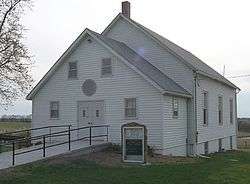
Far West became a ghost town soon after the departure of most of the Mormon population. The county seat was moved to Kingston, Missouri[4] and many of the log houses in Far West were relocated. John Whitmer continued to live in the nearly empty town, where he owned a large farm.
Today Far West is a historic site seven miles (11.26 km) south of U.S. Route 36 on Missouri Route D. The Church of Jesus Christ of Latter-day Saints maintains a historic site there, including the cornerstones of the planned temple. It also honors the Far West legacy in the name of a ward located in Cameron and, since 2015, a stake centered in Gallatin. The Community of Christ, formerly known as the Reorganized Church of Jesus Christ of Latter Day Saints, has a branch congregation that meets in Far West.
In 2004 construction began on a historic village adjacent to the temple site. It is operated by the Far West Historical Society to accommodate and increase tourism. The Country Store has been in operation since 2006.
In May 2012, The Church of Jesus Christ of Latter-day Saints confirmed that it purchased 6,000 acres of Missouri farmland and three historical sites from the Community of Christ.[5]
References
- ↑ National Park Service (2010-07-09). "National Register Information System". National Register of Historic Places. National Park Service.
- ↑ H. Roger Grant (April 1970). "National Register of Historic Places Inventory Nomination Form: Far West" (PDF). Missouri Department of Natural Resources. Retrieved September 1, 2016.
- ↑ "Caldwell County Place Names, 1928–1945 (archived)". The State Historical Society of Missouri. Archived from the original on June 24, 2016. Retrieved September 7, 2016.
- ↑ "Disappearing Missouri Names". The Kansas City Star. March 19, 1911. p. 15. Retrieved August 15, 2014 – via Newspapers.com.

- ↑ Askar, Jamshid Ghazi. "LDS Church buys farmland, Haun's Mill, Far West, Kirtland property from Community of Christ", Deseret News, Salt Lake City, May 5, 2012. Retrieved on September 14, 2012.
- Stephen C. LeSueur, The 1838 Mormon War in Missouri, University of Missouri Press, 1990.
- Alexander L. Baugh, A Call to Arms: The 1838 Mormon Defense of Northern Missouri, BYU Studies, 2000.
- John Hamer, Northeast of Eden: A Historical Atlas of Missouri's Mormon County, Far West Cultural Center, 2004.
External links
Coordinates: 39°40′16″N 94°07′54″W / 39.67111°N 94.13167°W
